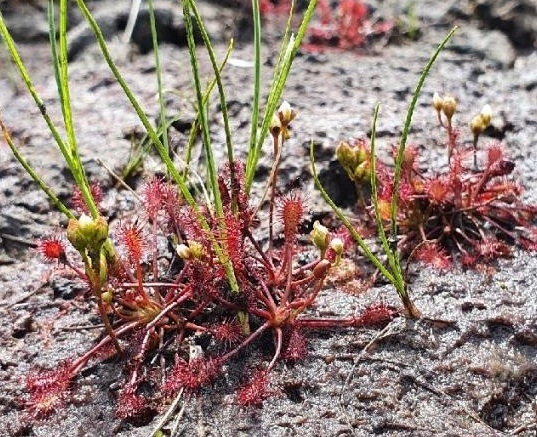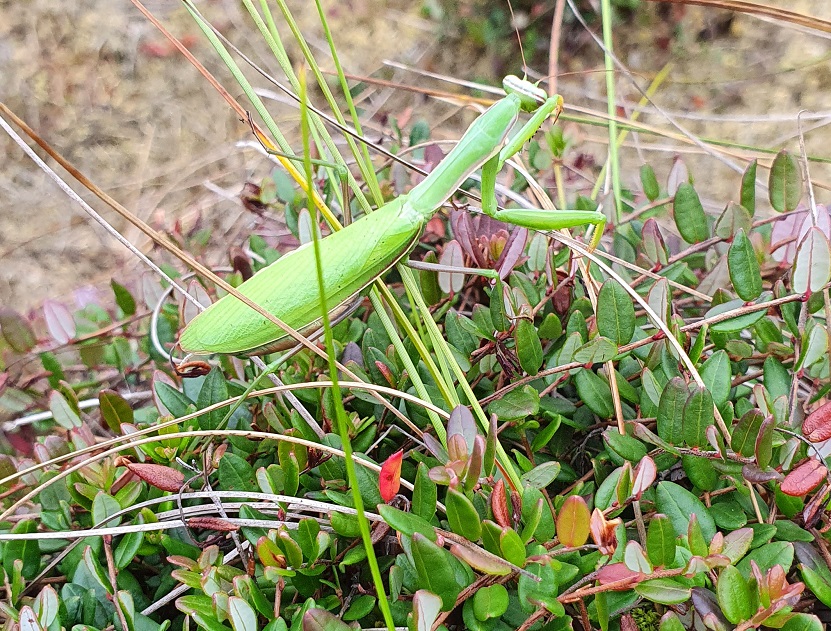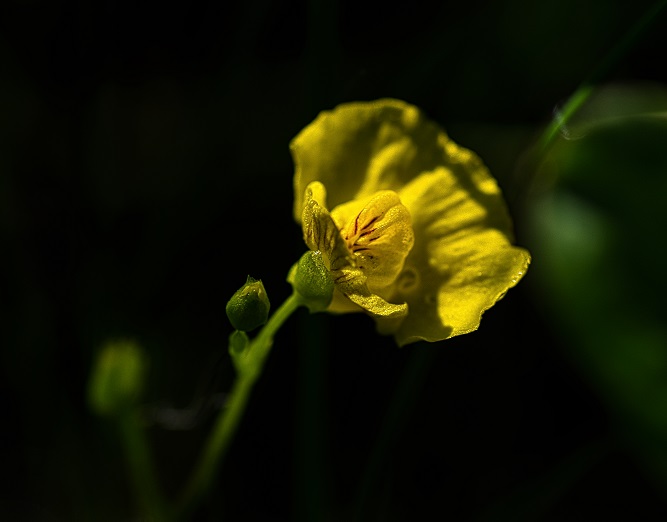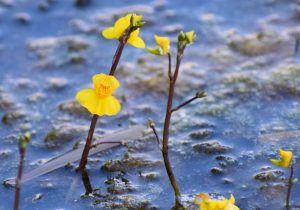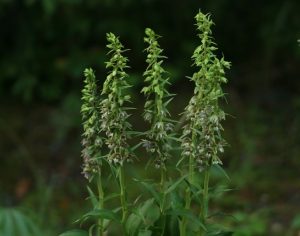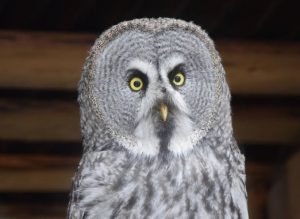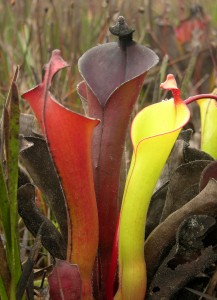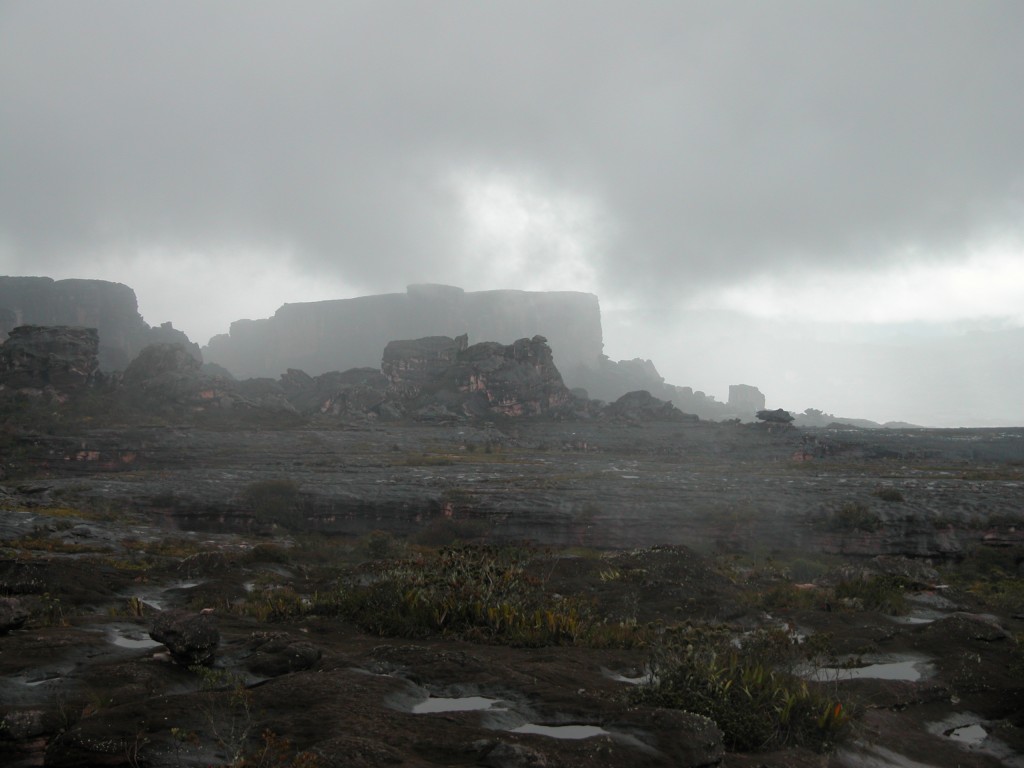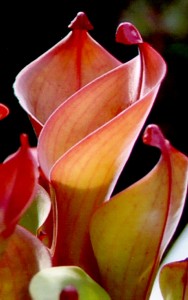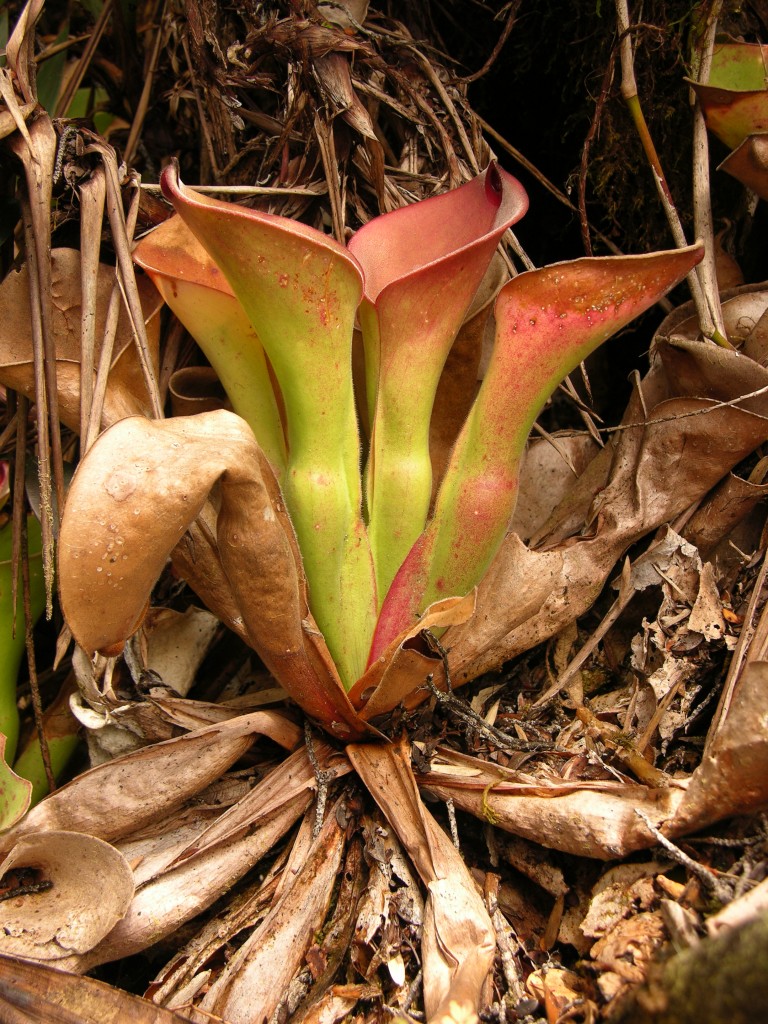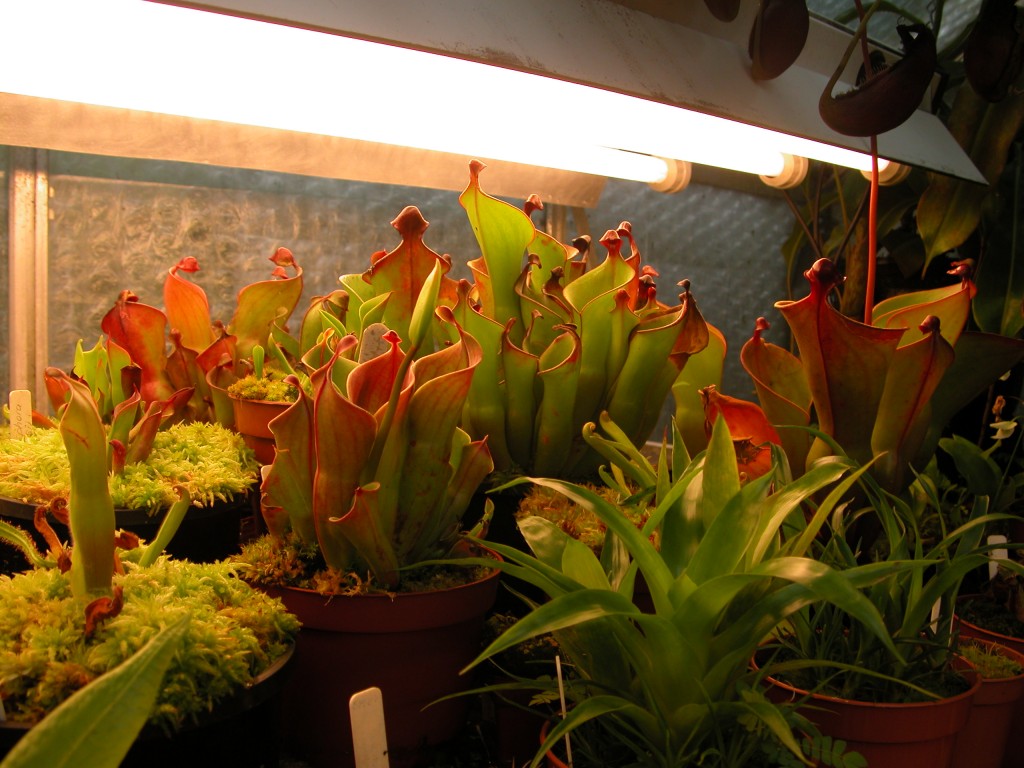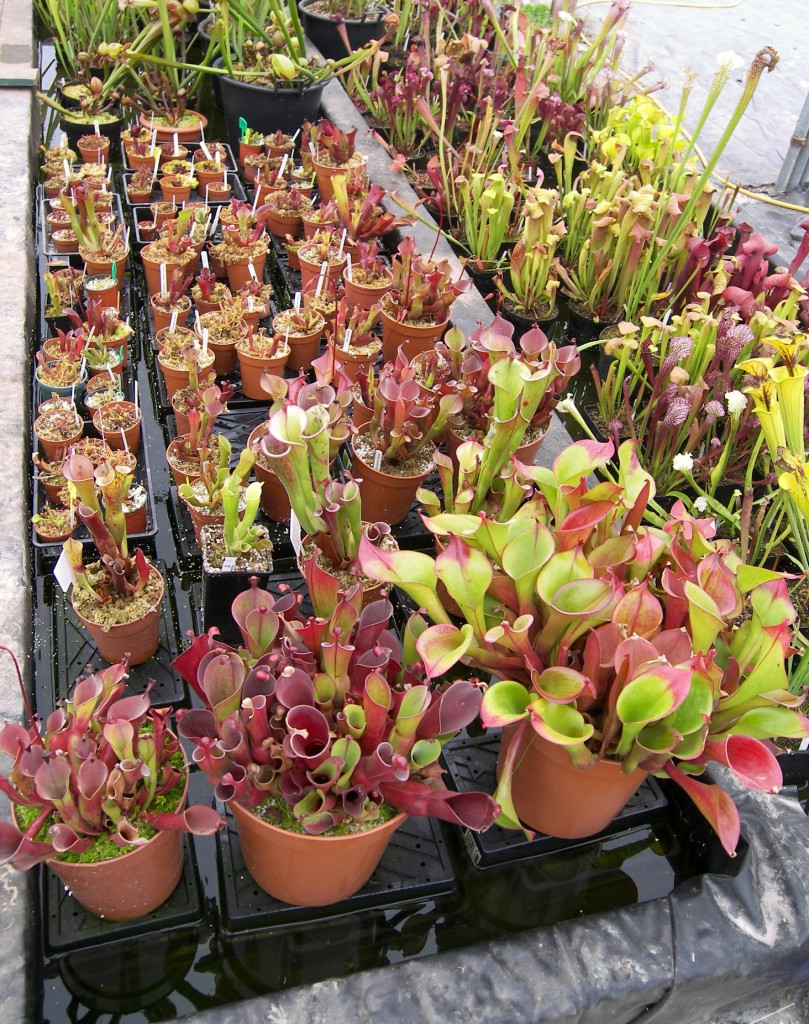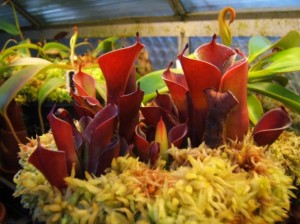In South America, on the summits of the vast plateaus of the Guiana Highlands, there grows a strange and little known group of carnivorous plants called the Heliamphora, or Marsh Pitcher Plants. Heliamphora was first discovered in 1838 by Robert Schomburgk, a cartographer who had been hired by the British government of the colony of British Guiana (now the independent country of Guyana). Schomburgk had undertaken a survey of the boundary between the colony of British Guiana and Venezuela and ventured to the foothills of Mount Roraima where he discovered Heliamphora growing in a rich swampland that he named the “botanical El Dorado”. Today fifteen species of Heliamphora have been formally described, many very recently owing to the ongoing exploration of their remote habitats.
The trapping process which the Heliamphora have evolved is relatively simple and essentially similar to that of other six genera of pitcher plants distributed around the world. Insects are attracted to the leaves by their vibrant colouration and profuse secretions of sweet nectar. In order to reach the nectar, a visiting insect is forced to scale the waxy, slippery interior surface of the leaf and hang vertically at the back in order to reach the nectar, however a foothold is very difficult for the insect to maintain and the slightest movement of the leaf in the wind or a falter by the insect causes the victim to fall straight down into the depths of the trap and into the digestive liquid contained within. The lower parts of the interior surface of leaves are lined with long, spine like, downwards pointing hairs which present a formidable barrier and prevent the insect from climbing up the waxy interior surface of the leaves to safety. Eventually the victim drowns within the leaf and its small body is broken down and releases nutrients that are absorbed by the plant which provides a reliable and very significant source of nutrients and enables the plant to survive in environments irrespective on the availability of nutrients in the substrate.
In most cases, the leaves of Heliamphora are extremely colourful, often being coloured yellow, purple, orange or green and this makes the Heliamphora very desirable to grow in cultivation. Although one species, Heliamphora nutans was introduced over 100 years ago into cultivation in Europe, for the most part, Heliamphora have remained relatively obscure and little grown until very recently. Now though, all fifteen species of Heliamphora are in cultivation and are increasingly grown and collected by horticulturalists around the world. Cultivation of the Heliamphora is not easy, but when a few important requirements are understood, these spectacular plants can be grown successfully.
One of the most important aspects in attempting to grow Heliamphora is to understand the extreme and unusual habitats in which they naturally occur. All fifteen species of Heliamphora primarily occur on the summits of the great tablelands of theGuiana Highlands, in most cases, each species is found on just one or two individual plateaus.
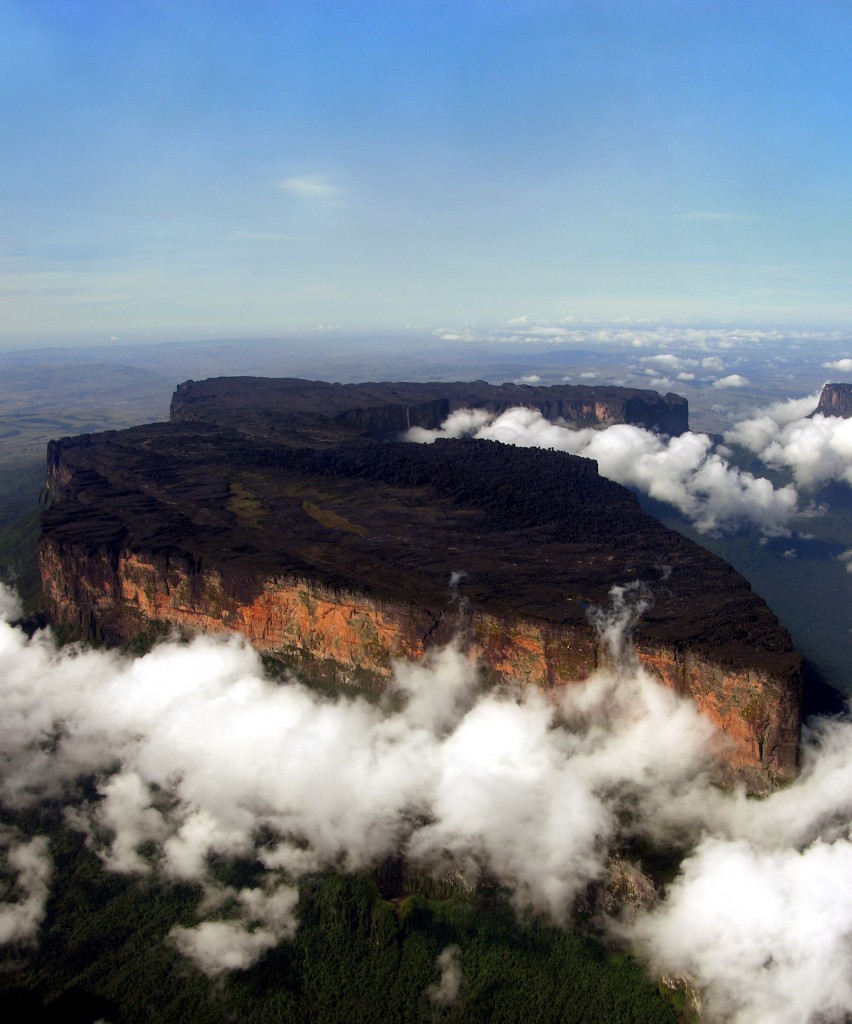
Mount Roraima – the home of Heliamphora nutans – the first species of Heliamphora that was discovered
Much like the genus Sarracenia (the North American pitcher plants), the Heliamphora consistently grow in permanently wet habitats in substrate that is peaty and deficient in nutrients. In most cases, the Heliamphora grow in completely unshaded habitat and are exposed to the full intensity of the tropical, equatorial sunlight. The habitat of all species of Heliamphora lies between 2000 – 3000 meters above sea level and consequently is permanently relatively cool, the daily temperature range is typically between 15 – 28ºC throughout the year. The Heliamphora can be cultivated easily providing that five requirements relating to their habitat are understood.
Firstly, much like the Sarracenia, the Heliamphora naturally grow in areas where water is permanently abundant. On the lofty summits of the great tablelands of the Guiana Highlands, rain falls every day and the level of humidity is permanently between 80 – 100%. As a result, Heliamphora plants need to be grown in very moist, humid conditions and indeed if they dry out entirely, they will more than likely die. In cultivation, Heliamphora plants dislike being grown in pots that stand in permanent water, as this often causes the living plants to rot and it is instead preferable to grow Heliamphora plants in well drained pots and ensure that each plant is watered at least once a day so that the soil is permanently moist but not waterlogged. Due to the need for permanently high levels of humidity, Heliamphora need to either be grown in a terrarium set up, or close to a humidifier or misting system or in a different location where permanently high humidity can be maintained so that the growing environment is similar to the plants natural habitat.
The second important factor that needs to be considered in order to cultivate Heliamphora successfully is the type of water that is used. Heliamphora, like most carnivorous plants, are extremely sensitive to impurities in water. In their natural habitats on the summits of the tablelands of the Guiana Highlands, Heliamphora plants constantly receive pure, clean rain water that largely lacks nutrients or minerals. Chlorinated water from taps in most towns and cities is usually toxic to Heliamphora and most other carnivorous plants since it contacts chemicals which destroy the delicate root systems of these plants. In most cases, Heliamphora cannot therefore be watered with regular water from the tap since this may cause the plants to die. Instead, for best results, Heliamphora plants should be watered only with rain water which is free of the chemicals and more akin to the water which the plants naturally receive in the wild. Rain water should be collected for Heliamphora plants, and this can easily be achieved by use of a water butt or pond linked to a gutter system of a house. Collected rainwater can then be stored and used to water Heliamphora plants as necessary.
The third important factor that must be considered in order to cultivate Heliamphora successfully is the type of soil that is used. Heliamphora plants, like most carnivorous plants, are very specific with regards to the type of soil in which they can grow. This is because these plants have evolved to become carnivorous in habitats that are deficient of nutrients and minerals and consequently their root systems are unable to absorb water or minerals if nutrient concentrations are too high. As a result, Heliamphora plants need acidic soil that is lacking in most nutrients. The best compost to use in cultivation to grow Heliamphora plants is a loose mix of peat, perlite, vermiculite and living sphagnum moss mixed roughly at an equal ratio. The resultant medium should be loose and uncompacted when plants are potted, to ensure that the soil strains quickly and fully to avoid the rotting of living plants. Much like most carnivorous plants, if Heliamphora plants are potted in regular compost for normal house plants, they will usually die due to the abundance of nutrients in the soil. Also as with other carnivorous plants, fertilizing Heliamphora plants can also result in their death, and it is generally advisable not to apply any fertilizer at all. If living sphagnum moss is used in the compost of Heliamphora, usually, the sphagnum moss will continue growing and eventually cover the upper parts of the pot, surrounding the living Heliamphora plant. This is preferable since the moss significantly increases the humidity around the living plant and provides a preferable growing environment.
The forth important growing requirement in the cultivation of Heliamphora is temperature. Since all species of Heliamphora occur between 2000 – 3000 meters above sea level, in the wild, these plants never experience extremely hot temperatures, which can be fatal in cultivation. The idea temperature range for Heliamphora plants in cultivation is a daytime maximum temperature between 20 – 25ºC. While Heliamphora plants can tolerate higher temperatures, growth is more vigorous when temperatures are below 25 ºC. Unlike the two closely related genera of pitcher plants from North America (Darlingtonia and Sarracenia), the temperature range of the habitat of Heliamphora plants is more or less even throughout the year and so Heliamphora do not naturally experience any period of dormancy. Instead, they can be grown continually throughout the year and flower sporadically when mature, at intervals of 6 – 12 months.
The last aspect of the cultivation of Heliamphora that needs consideration is the amount of sunlight which Heliamphora plants should receive. Growing on the elevated summits of the great South American tablelands within a few degrees from the equator in generally unshaded habitat, the Heliamphora are naturally exposed to extremely bright light. Indeed, much like the Sarracenia, if light levels are inadequate, Heliamphora plants will produce long, etiolated, spindly leaves that are predominantly green and weak. Heliamphora plants produce the most colourful foliage when grown in strong or preferably direct sunlight and in such conditions, the leaves of most species will develop spectacular, red, yellow or purple colouration.
Since the growing requirements of Heliamphora require relatively cool temperatures and high humidity, many horticulturalists prefer to grow Heliamphora plants in a terrarium placed in a cool location (such as a garage). The terrarium can easily be illuminated brightly with several fluorescent lights, and the result is an environment that is perfect for the cultivation of Heliamphora plants. In temperate countries, Heliamphora can sometimes be grown in greenhouses amongst other carnivorous plants such as Sarracenia, Darlingtonia, Drosera and Pinguicula (see below).
Providing that a cool, wet lit, humid environment can be provided, Heliamphora plants potted in the appropriate compost and watered with rainwater will usually flourish. From seed, Heliamphora plants grow quite slowly and require at least four years to reach maturity, however fortunately, it is increasingly possible to purchase established specimens which is usually preferable. Mature Heliamphora plants rapidly form large clumps which can be regularly divided so that cuttings can be made. Much like the North American Sarracenia, the leaves of all species of Heliamphora secrete nectar in order to attract insect prey and this causes the plants foliage to have a very sweet, often like honey-like aroma which is very pleasant. For readers that are interested in gaining a more complete understanding of how to successfully cultivate Sarracenia plants, I recommend the works of D’Amato (1998), Slack (1979, 1986) and Rice (2006) as these books provide excellent accounts on how to cultivate Heliamphora plants successfully.
In contrast to the North American pitcher plants, (Darlingtonia and Sarracenia) the Heliamphora remain little effected by the activities of man, see McPherson (2006). Their habitats remain remote and largely inaccessible and this has protected the Heliamphora from habitat distruction and disturbance by humans. Indeed populations of most species of Heliamphora that occur on the lofty summits of the South American tablelands are so seldom visited that they generally remain in a virtually pristine, natural state, so the future outlook for the survival of these rare but very beautiful plants is positive and indeed long may it remain so.
Heliamphora plants can be purchased from the following sources:
Hewitt-Cooper Carnivorous Plants (a specialist nursery that focuses on Drosera) TheHomestead, Glastonbury Road, WestPennard, Somerset, BA6 8NN, United Kingdom Website: www.hccarnivorousplants.co.uk Hampshire Carnivorous Plants Ya Mayla, Allington Lane, WestEnd,Southampton, SO30 3HQ, United Kingdom Website: www.hantsflytrap.com P&J Carnivorous Plants The Hayden, Brampton Lane, Madley, Hereford, HR2 9LX, United Kingdom Website: www.pj-plants.co.uk Sarracenia Nurseries 37 Stanley Park Road, Carshalton, Surrey, SM5 3HT, United Kingdom Website: www.sarracenia.co.uk Shropshire Sarracenias 5 Field Close, Malinslee, Telford, Shropshire, TF4 2EH, United Kingdom Website: www.carnivorousplants.uk.comBibliography
- D’Amato, P. 1998. TheSavageGarden: Cultivating Carnivorous Plants.Berkeley, CA: Ten Speed Press.
- McPherson, S. 2006. Pitcher Plants of theAmericas. Blacksburg, Virginia, The McDonald & Woodward Publishing Company.
- Rice, B., 2006. Growing Carnivorous PlantsPortland, OR: Timber Press.
- Slack, A. 1979. Carnivorous Plants. London,England: Ebury Press.
- Slack, A. 1986. Insect Eating Plants and How to Grow Them. London, England: Alpha Books.
Stewart McPherson
